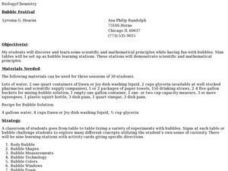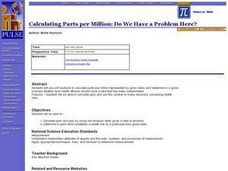Curated OER
Industrialization, Chemicals and Human Health - Math
Learners review the units of the metric system, and practice estimating measures before actually converting between the two systems of measurement. They participate in activities to visualize a concentration of one part per million....
Curated OER
Measuring Activities
Students measure using both metric and standard measures. They convert from one standard to the next while measuring distances in their home or classroom.
Curated OER
Bubble Festival
Students practice scientific inquiry while learning about bubbles. In this lesson plan about bubbles, students explore characteristics of bubbles. Students move through nine different "bubble" stations following directions and completing...
Curated OER
How Small is It?
Students better understand what a concentration of one part per million means through activities. Students discuss "Maximum Contaminant Level" of a toxic in the water. They measure the classroom to find out how many cubic centimeter...
Curated OER
Mr. Goldman's Good Idea
Shopping carts are a modern convenience that many people take for granted. Make sure your pupils do not fall into that category by completing the activities in this plan. There are ideas included for language arts, social studies, math,...
Curated OER
Math Lesson: Just How Many is a "Million Dead"?
Students are able to convert large numbers into meaningful ratios. They are able to conceptualize 1 million. Students grapple with the concept of a million. They use this activity to convey the idea of millions by converting war death...
Curated OER
Calculating Parts per Million: Do We Have a Problem Here?
Students calculate ppm and ppb by using unit analysis when given a ratio of amounts.
They determine in ppm what constitutes a health risk for a particular toxin given data
and whether local health officials should close a lake...
Curated OER
Biomagnification
Students use real data to create an algebraic equation. They explain how the build up of small levels of contaminates can quickly become detrimental to species higher in the food chain.
Curated OER
How Big is it?
Students review the units of the metric system, convert from the US system of units of measure to the metric system, and estimate measures before converting between the two systems of measurement.
Curated OER
Math Lesson: What Do You Want to Know? - Country Statistics
Learners are able to identify the characteristics of a variety of graphs (i.e. bar graph, line graph, pie graph, scatter plot, population pyramids, etc.) They recognize how the type of data to be presented plays a role in choosing the...
Curated OER
Fertilizers, Pesticides and Health
Students apply real data to create and calculate algebraic equations. Students create a visual to represent the concentration for one part per million and apply unit analysis to verify measurement computations. Students define the use...
Curated OER
Bar and Histograms (What Would You Use: Part 1)
Students practice creating bar graphs using a given set of data. Using the same data, they create a group frequency chart and histograms. They must decide the best graph for the given set of data. They share their graphs with the...
Curated OER
Line & Scatter (What Would You Use: Part 2)
High schoolers discuss line graphs and scatter plots and the best situations in which to use them. Using the graphs, they determine the type of correlation between variables on a scatterplot. They create a scatterplot and line graph...
Curated OER
What Pie?
Students practice making and interpreting pie graphs so they are better able to decide if a pie chart is the appropriate form of display. Students examine included overheads of different pie charts, and directions on how to make pie...
Curated OER
Who Gave It to You?
Students use logic to locate the primary cases, the people who started the spread of the disease through the population. They graph the data of the number of people infected over time (exchanges) and determine an equation that best fits...
Curated OER
Mapping Natural Disasters
Students use Cartesian coordinates to plot current natural disasters. They relate location of natural disasters to their specific major project countries. Students tie in geometry within this instructional activity as connected to...
Curated OER
Population Pyramids
Students create a population pyramid based on current data for their final project country. They analyze data from comprehension trends of final project country. Students analyze populations of specific countries.
Curated OER
Math Lesson: How Many People Live There?
Students are able to calculate the population density of a country, and calculate the population density of large cities in that country. They are able to create an appropriate graph to represent their data for that country.
Curated OER
Math: Who Makes an Epidemic?
Students calculate the threshold value for the number of susceptible people needed to create an epidemic. They examine a real life flu epidemic and use the SIR model to solve the problems. Students discover they can use mathematics to...
Curated OER
QwikQure Algebra
Fourth graders are introduced to the problem using a bottle of medicine. They estimate the volume of the medicine and predict the instructions on the bottle. They then think about how they might solve the problem before asking them to...





















